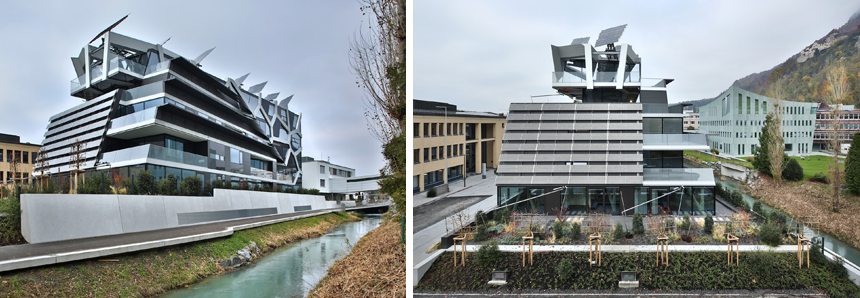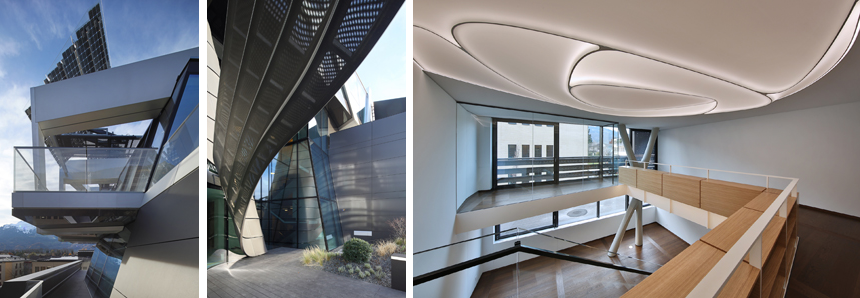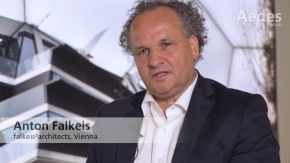The futuristic "active energy building", an apartment building in Vaduz, is the prototype of a new urban, decentralized power generation system that represents a trend-setting model for energy generation and distribution. It is the main focus of the exhibition, which details the extensive research work by the Austrian architects Anton Falkeis & Cornelia Falkeis-Senn with their results on numerous advances in terms of material, construction and network design for the development of active buildings. By means of further projects, the office presents its innovative strategies that help to tackle the major societal challenges, such as climate change, energy and resource scarcity. Photographs, texts, drawings and architectural models also give insight into other cultural buildings and infrastructure.
Cities are currently responsible for about 75 percent of the world’s energy consumption and about 80 percent of man-made carbon dioxide emissions. Today, urban agglomerations are home to more than 50 percent of the world’s population. Given these facts, compounded by increasing urbanization, the architect duo of falkeis²architects is seeking new strategies to reduce CO2 emissions and energy consumption.

Active Energy Building in Vaduz, Liechtenstein © Roland Korner
Their “active energy building” is one of the ways they are showing how sustainable architecture can make a significant contribution to reaching the goal of climate neutrality by 2050. In cooperation with university researchers and industry partners, the architects have developed several new materials and techniques that enable a complex system of energy generation.
Completed in 2017, the five-story building is located in the middle of the dense, small town of Vaduz in Liechtenstein. It comprises 12 housing units of different sizes, with a total usable area of 3,200 square meters. It adapts easily to changing space requirements thanks to an extremely effective supporting structure made of reinforced concrete.

Active Energy Building in Vaduz, Liechtenstein © Roland Korner
With an integrated energy generation system, the “active energy building” produces more energy than it consumes. The basis for this sustainable energy technology is geothermal energy, complemented by the passive and active consumption of energy generated by solar panels and “climate wings”. Surplus energy is used to supply neighboring buildings via a networked structure and also feeds into the public electricity grid. Positioning forward-looking architecture as a motor for improving the quality of life, the building was nominated for the “Renewable Energy and Energy Efficiency” sustainability award at the International Lake Constance Conference 2017.
The exhibition “Active Buildings – Innovation for Architecture in Motion” shows this and other designed and built projects based on applied transdisciplinary research – the basis for the architectural work of falkeis²architects.

Connecting Link, Wien © falkeis²architects
“connecting link” was their contribution to an EU-wide competition for a pedestrian and bicycle bridge over the Danube Canal in Vienna. For reasons of flood safety and the navigability of the canal, the competition required that a movable bridge be designed. In collaboration with the civil engineer Harald Kloft, falkeis²architects designed a light and dynamic tilting bridge. Designing the bridge as semi-monocoque structure reduced its weight to a third of a traditionally designed bridge of the same length.

Giant Instrument, Salzburg © falkeis²architects
The “giant instrument” is another competition entry (2nd place) presented in the exhibition. The team of Falkeis and Falkeis-Senn, together with the structural engineers Spirk & Partner, Waagner-Biró, and Siemens Bacon, developed a movable roof for the Felsenreitschule – a theater and a venue of the Salzburg Festival, arguably the world’s most important festival of classical music and the performing arts. Designed to work as part of the stage machinery, the roof opens up to transform the interior into an open-air stage within five minutes. The system consists of four flaps, each 11 meters wide, which can be lifted and lowered like fingers.

Mauthausen Memorial, Mauthausen © falkeis²architects
The “mauthausen memorial” is an installation designed for the stage of an open-air commemorative event that took place in 1998 in the quarry of the former Mauthausen concentration camp in Austria. In collaboration with acoustics expert Karlheinz Müller, a 3D sound system was developed that enabled the acoustic impressions of the space to change in response to a performance of a composition by Joe Zawinul. Developed and implemented together with the engineer Klaus Bollinger, the stage installation was intentionally not enclosed, leaving free views of the quarry walls behind it. A lightweight object made of fabric and ropes, the illuminated membrane-like structure seemed to float above the stage.
About falkeis²architects
Anton Falkeis and Cornelia Falkeis-Senn run the offices falkeis.architects_vienna (since 1988), falkeis.architects_vaduz, and falkeis²architects.building innovation lab (both since 2011). Their architectural work has been widely published, and their projects and installations presented at the biennales in Venice, Kuala Lumpur, New York, Los Angeles, and Vienna. They are JSPS Fellows at the Japan Society for the Promotion of Science.
MANY THANKS FOR THE SUPPORT
Österreichisches Kulturforum Berlin











